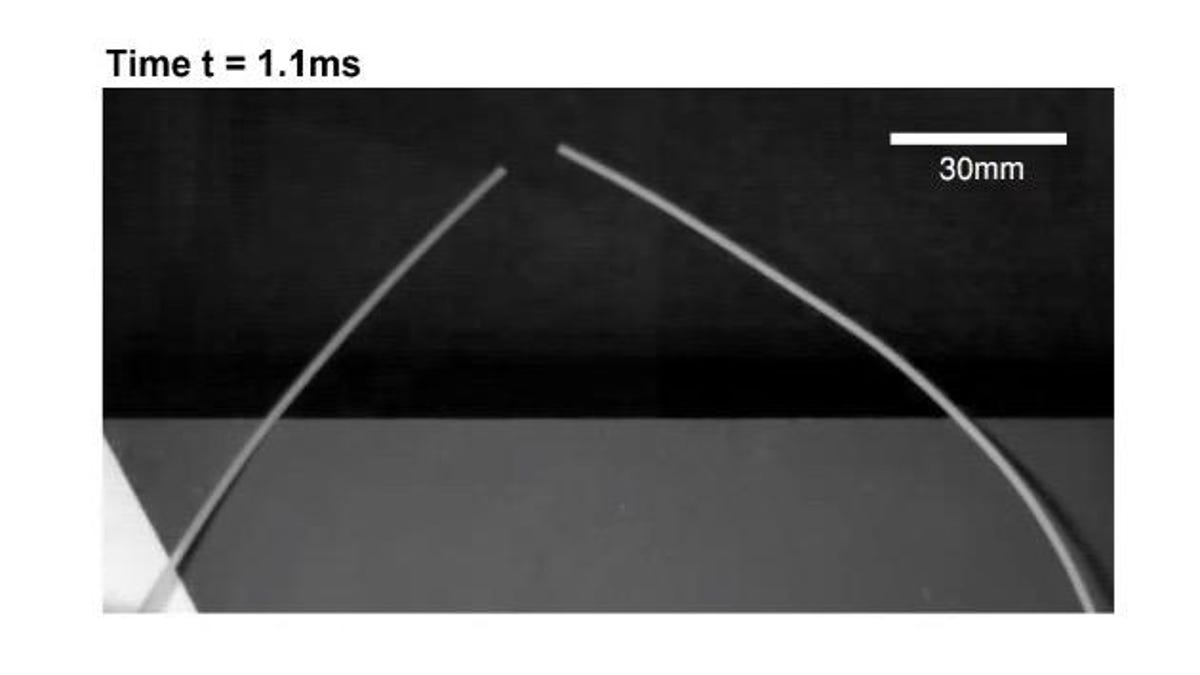MIT scientists solve a pasta puzzle, how to break spaghetti in two
Mathematicians figure out how to evenly snap dry spaghetti noodles.

Here we see the even fracture of a spaghetti noodle created at low speeds during the experiment.
Anyone who's cooked pasta knows it's nearly impossible to break dry spaghetti noodles into two neat pieces. Usually, as the noodles bend, they split into a few large pieces and then splinter into tiny ones that fall onto the kitchen floor and roll under the stove.
Those unusual shattering patterns of dried spaghetti sticks have stumped scientists for years. But now MIT mathematicians have put their heads together to solve the pasta mystery and show how breaking the dry noodles into two (and not two dozen) pieces can be accomplished.
Their new study, published on Monday in the open access journal Proceedings of the National Academy of Sciences (PNAS), show that researchers have discovered the best way of breaking pasta into two even pieces.
The paper's authors include two MIT university students, Ronald Heisser and Vishal Patil, MIT mathematics professor Norbert Stoop, and Emmanuel Villermaux of Université Aix Marseille in France.
"Understanding and controlling fracture dynamics remain one of the foremost theoretical and practical challenges in material science and physics," the studysays.
Fracture behavior of elongated, brittle objects such as fibers -- or, in this case, pasta -- has previously been studied in the 1950s by Nobel Prize winner Richard Feynman.
He documented that dry spaghetti almost always breaks into more than two pieces when bent.
Then in 2005, French physicists Basile Audoly and Sebastien Neukirch of the Université Pierre et Marie Curie further studied Feynman's work.
The scientists discovered through their experiments that when a stick is bent evenly from both ends, it will break near the center curve, creating a "snap-back" reaction or vibration, that further breaks the stick into multiple pieces until the vibration subsides. Their study won them the 2006 Ig Nobel Award for physics.
Here the even fracture in a spaghetti noodle is observed in experiments and simulations at high twist angles.
But for this current study, the MIT scientists decided to build a machine specifically used to controllably twist and bend hundreds of two types of spaghetti sticks -- Barilla No. 5 and Barilla No. 7 (both have slightly different diameters.)
Each end of the machine had a clamp that held a stick of spaghetti in place. One clamp would rotate and twist the dry noodle by various degrees, while the other clamp slid toward the twisting clamp so that the spaghetti would bend.
The researchers discovered through their experiments that if the the spaghetti is twisted at 270 degrees and then carefully and slowly bent at the speed of 0.11 inch (3 millimeters) per second, it will indeed snap perfectly into two equal pieces.
While this may seem like the kind of study only foodies and chefs would care about, the mathematicians believe their data could help scientists figure out how to control fractures in other spaghetti-shaped materials such as "engineered nanotubes or microtubules in cells," according to a report from MIT News.
Culture: Your hub for everything from film and television to music, comics, toys and sports.
Solving for XX: The tech industry seeks to overcome outdated ideas about "women in tech."

